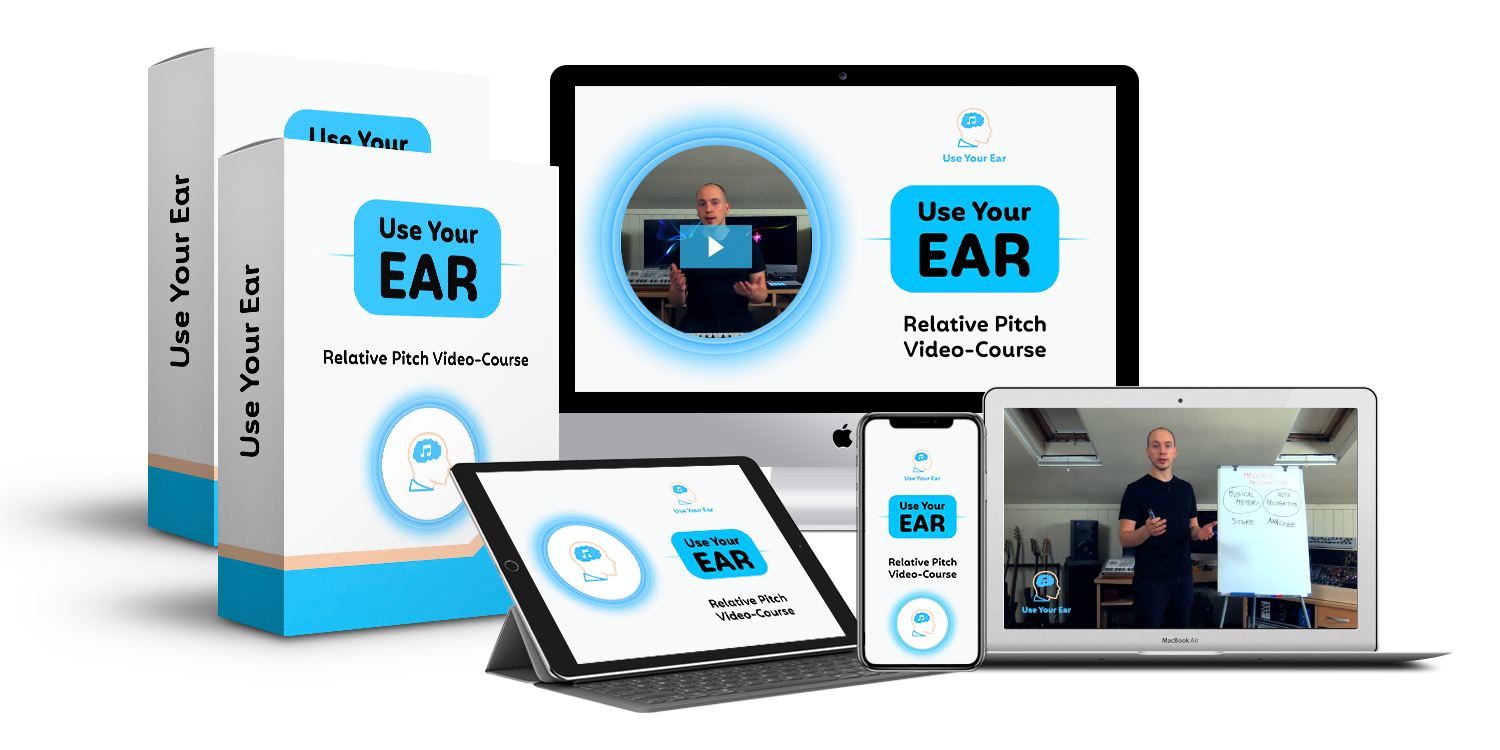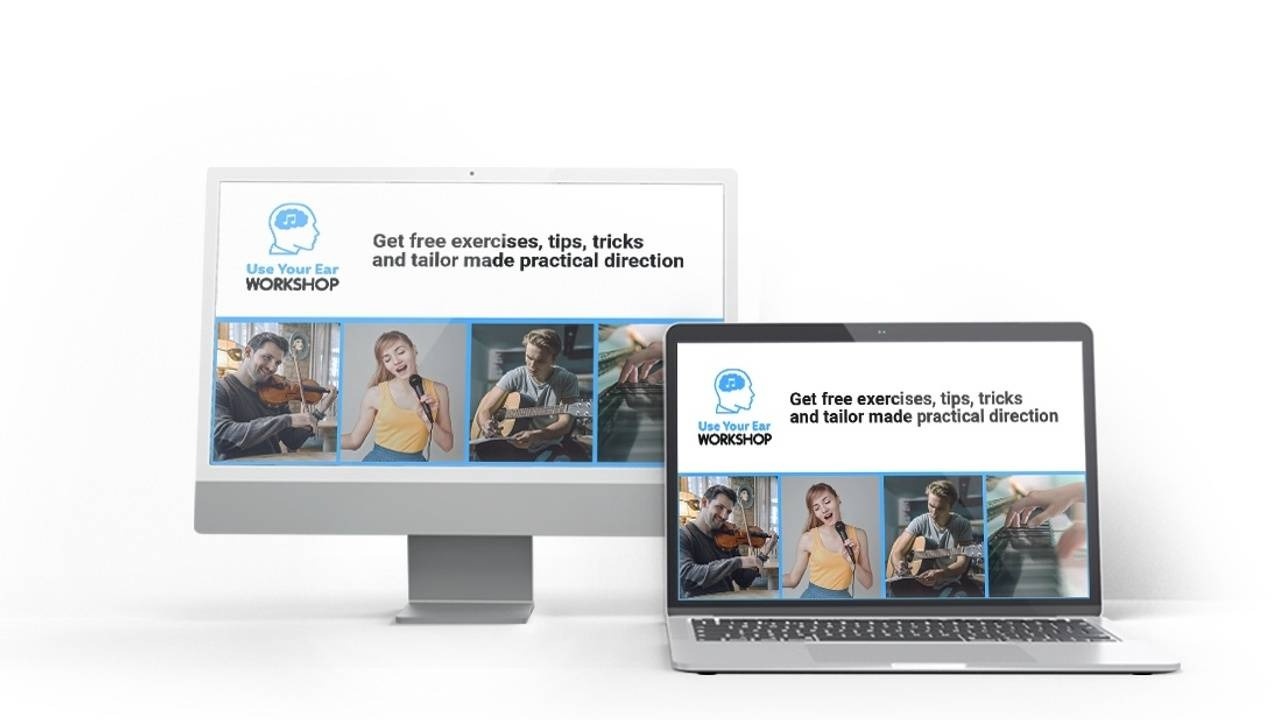Ear Training for Musicians
Ear training is an essential aspect of musicianship and a skill no well-rounded musician can do without. A properly trained ear doesn’t just make you a better player. It allows you to be free with music; to improvise and create, not just follow along.
Once you understand how to use your ear and how to connect your ‘inner ear’ to your instrument, you will have the confidence and flexibility to do whatever you want within a musical framework, with a solid foundation that supports all of your musical choices.

What is ear training?
Ear training is the process of teaching your brain to recognize and produce different musical elements (notes, chords, etc). Most ear training discussion centers around pitch recognition (which is surely the most difficult part for musicians to master), but in general ear training for musicians actually encompasses all aspects of music: rhythm, pitch, melody, chords, harmonic progressions, and scales.
Ear training gives you the ability to create music organically and instinctively, without copying or simply reproducing rote memorized patterns.
Difference Between Perfect Pitch and Relative Pitch
Under no circumstance should you think that perfect pitch is a necessity for ear training for musicians. Having a mental connection to music and a strong inner ear doesn’t imply perfect pitch. Rather, it implies a solid understanding of relative pitch, a much more powerful and useful musical tool.
Perfect pitch is the ability to produce or recognize a note ‘out of thin air,’ outside of any musical context, with no prompting whatsoever. While this is a cool thing to be able to do, it is more of a party trick than a usable tool. Music does not exist outside of a musical context. At no point in your musical education or career will you be required to pluck notes out of the air at random. That’s just not how music works.

Perfect pitch is also not something that can be taught or developed after early childhood. It is a rare condition that a small percentage of the population has, and an even smaller percentage of musicians. Only about 4% of musicians report having perfect pitch. Plenty of successful musicians do very well without it.
Relative pitch, on the other hand, is the ability to produce and recognize notes and sonic sensations within a musical context - aka "a tonality", and to use those notes to create interesting harmonies and melodies inside that established tonality. It is much more useful to understand how things like notes and chords function than it is to be able to reproduce isolated pitches and intervals in a vacuum.
Essential ear training for the contemporary musician must include relative pitch training.
The Importance of Ear Training for Musicians
Most musicians get into music because they fall in love with an instrument or hear a piece of music that they love. They might spend many years developing the physical technique to play fast, complicated patterns, or read music, or sing very high or very low notes.
At some point, however, many musicians discover that they are held back by a lack of harmonic understanding because they have neglected to train their ears. They may have great technique, but they are trapped in a box that only allows them to play a restricted set of elements, mostly based on muscle memory they’ve developed in their practice.

Ear training for musicians opens up that box, allowing the musician to move beyond muscular pattern memorization and repetition. With good ear training skills, musicians become truly free to express the sounds they hear within, and to have deep musical dialogue with other players.
Here are some excellent articles you can check out if you are interested in learning more about ear training exercises for specific instruments or musical styles:
- Ear training for guitar players
- Ear training for jazz musicians
- Ear training for pianists
- Ear training for violin players
Effective vs Ineffective Types of Ear Training for Musicians
Unfortunately, not all ear training methods are alike. Some are incredibly useful and will serve you well, while others will only continue to box you in and prevent you from moving forward.
Interval Training
One of the most popular and most frequently talked about methods of ear training for musicians is interval training or learning intervals. Many free online ear training exercises are interval training exercises. In fact, even the ‘best ear training app for musicians’ teaches this approach. Unfortunately, however, interval ear training is not an effective method of training your ear.
Interval training means learning to recognize and reproduce the intervals (distances) between notes. For example, learning what a major third, a perfect fourth, an octave, etc. sound like.
The problem with interval-based ear training is that, like perfect pitch, it exists outside of a musical context. It does not help you develop an understanding of what intervals and pitches sound like within a tonality. For this reason, it is absolutely ineffective.
Many musicians who have spent long hours practicing and memorizing intervals become frustrated when they later hear those same intervals inside a harmonic structure and don’t recognize them. For example, a major third between the first and third notes of the V chord (the chord built on the 5th degree of the major scale) sounds completely different from the major third between the first and third notes of the IV chord (the chord built on the 4th degree of the major scale) .
The takeaway here is: intervals sound different depending on the musical context they are included in, so it doesn’t make sense to practice recognizing or producing them in isolation, as is done in interval ear training.
Trial and Error
Another commonly used method for ear training is trial and error. Many beginner musicians do this without really knowing they’re doing it, and without understanding that it is an ineffective tool that will hamper their learning in the long run.
The trial and error method involves using your instrument to pick out notes and chords. Musicians who adopt this approach (which is very common among beginners) play random notes/chords on their instrument until they find those that match the note/chord they hear in the song. The problem with this approach is that it makes you completely dependent on your instrument and does not develop your ‘inner ear’ or the ability to find the sounds on your own (without using any musical instrument).

Ear Training Tips For All Musicians
When it comes to ear training, a complete guide for all musicians must include a very different approach than simply practicing intervals in isolation. Proper ear training exercises for musicians must place those pitches within a musical context and help the musician develop a sense of the feeling and function of those pitches.
If you only ever sing notes, chords (or intervals) in isolation or in a certain order, you’re only strengthening your ability to reproduce those intervals under those exact circumstances.
Effective ear training for the contemporary musician must include three things. It must:
- be based on a tonal approach (not simply learning intervals in isolation, but learning the sonic sensation of notes and chords within a tonality);
- be step-by-step (break things down into small, manageable pieces that build on each other to form greater cognitive understanding);
- teach all of the relevant sub-skills necessary for ear training (pitch matching, tonic recognition, tonic retention, short-term musical memory, recognizing chord progressions, melodic recognition, etc.).
Finally, a good ear training method should help you develop a mind-to-instrument connection. This part, however, usually comes naturally later on if all the other parts of the method have been applied successfully.

Ear Training Exercises for Musicians
Here are a couple of tonal-based exercises for ear training that are easy to do and will help you develop your inner ear and mental connection to music.
1. Sing the Major Scale
Play the tonic note of the scale (the piano and guitar work well for this purpose.) Then, sing the whole scale up and down, returning to the tonic note. Then check to see if you sang it right by playing it on your instrument. If you need to, you can check each pitch against your instrument as you go, but you must sing the pitch first, then check it on your instrument, not the other way around.
2. Sing Scale Tones
Once you can easily sing a major scale up and down, move on to the next step. Play the tonic note of the scale and visualize the scale in your head. You can even try signing the scale up and down inside your head. Then, pick notes at random from the scale and sing those. Check each note after you sing it by playing it on your instrument.
Is Ear Training Your Main Goal? We Can Help You
The ear training method we teach at Use Your Ear are based on rigorous scientific studies that have proven which techniques are most effective and why. Not only that, our method has been used by thousands of students, who all report that they improved much more with our courses than with interval training or trial-and-error approaches.
Our method is tonal-based and 100% step-by-step. It can be used by students at any level to improve their inner ear and mental connection to music. We teach all the sub-skills necessary for ear training and work with students at their level to make sure that what they are learning is relevant and applicable.
Not only that, the exercises you’ll do with Use Your Ear are fun! You’ll learn to create real music, in real situations, using your creativity and instinct, not just repeating memorized patterns or learning complicated theory.


Relative Pitch Video-Course
Our relative pitch video course will help you to master your ability to understand and recognize musical pitch (notes, chords, etc.) using rigorously tested, scientific approaches, you will learn how to develop an instinctive feel for melody and harmony and will be able to immediately apply your new skills in real-life situations like jams, songwriting, choir practice, beat-making, and music lessons.
The Use Your Ear video course is available nowFree Use Your Ear Workshop
The free Use Your Ear Workshop is a great introductory lesson to our ear training methods, and a perfect way to dip your toe into ear training for musicians. In this three-hour workshop, you’ll practice lots of exercises that will teach you the best, scientifically proven way to train your ear, you’ll understand what exercises are appropriate for you depending on your current level, and you’ll come away with tools to continue your practice on your own.
Free online ear training workshop

Individual online lessons
If you’re looking to take your studies to the next level, our individual online lessons offer one-on-one guidance tailored specifically to your needs. Instead of working with an ear trainer app that doesn’t provide you with any useful feedback nor a deep understanding of the cognitive processes involved in ear training, a professional ear training teacher can help with concepts that you’re struggling with, or dig into advanced methods and techniques that deepen your musical understanding and slingshot you into greater musical freedom.
One-on-one ear training lessons onlineWho Are Our Courses For?
Our ear training courses are for anyone who wants to develop a deeper connection with music and have an effective pathway to developing their inner sense of musicality. It doesn’t matter if you’re a total beginner or a total pro. Whether you are training the ear for the improvising musician, or simply want to sing in tune to the radio, our lessons can help you do it.
We meet all our students where they’re at to provide a clear strategy and an actionable path forward. Get in touch today to start your ear training journey and start freeing up your musical mind.





